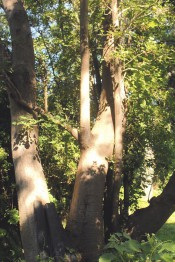Erythrina variegata L.
Frost-tender, spreading deciduous tree with many robust branches scattered with prickles, although sometimes unarmed, broadly diamond-shaped leaves, to 40cm long, rich green and variegated light green and yellow along the main veins, and dense terminal racemes of scarlet or crimson flowers, to 20cm long, appearing mainly when the tree is leafless. To 25m. [RHSE, Hortus].
Horticultural & Botanical History
‘Dudap, or Dudap of the Malays; and when employed to support the black pepper vine, for which it is very generally used, they call it chinkereen.
A pretty large tree, and common over India and the Islands. Flowering time the beginning of the hot season, in March and April. Seed ripens in June and July.
This tree is employed, in many parts of India, to support the black pepper vine. See Marsden’s History of Sumatra, page 107. The best method for raising them is by planting cuttings of about eighteen inches, or two feet long, and about as thick as a man’s arm, half under ground, if planted of a greater length, the wind is apt to shake them, which prevents their striking root. From ten or more feet asunder, according to the quality of the soil, and in quincunx order, is from my experience, the best way.
What seems to render these trees very proper for this purpose, is their quick growth, their firm, permanent, though smooth bark, which never peels off, and gives firm hold to the roots of the vine, which come out abundantly at the joints. And lastly, they are full of leaves, and very shady during the hottest months of the year, which shelters the vines from the intense heat of the sun, and keeps the ground moist. As soon as the hottest weather is over, the leaves drop and expose the vines to the sun and weather during the cool season, which I conceive renders them more healthy, and of course more productive. They must be kept in a dwarf state, by topping, and cutting off the lateral branches, for if allowed to grow without interruption, they would soon arrive at very great height, which would be very unfavourable for collecting the pepper.
The immense quantity of large leaves that fall annually from these trees, manures the ground below them, which becomes more and more fertile, the longer it remains in this state; so that when the vines have done bearing, the land must be in a much better condition than when first planted. Daily experience proves the truth of this.’ [Roxburgh FI p.249/1832].
History at Camden Park
Only listed in the 1850 catalogue. A large, very old specimen survives in the gardens, probably the form listed as Erythrina carnea. See Erythrina variegata L. var. carnea. Generally known under the name Erythrina indica.
Notes
Erythrina indica Zoll. (1846) = Erythrina lobulata Miq., a Javan species.
Published Dec 19, 2009 - 04:58 PM | Last updated Jul 21, 2010 - 11:56 AM

Erythrina variegata L. | Camden Park garden. The greyish, rather thin bark is clearly see. | George Taylor
| Family | Fabaceae |
|---|---|
| Category | |
| Region of origin | Widespread in the tropics and sub-tropics from Africa to Asia. Also recognised in northern Australia |
| Synonyms |
|
| Common Name | Indian Coral Tree |
| Name in the Camden Park Record |
Erythrina indica |
| Confidence level | high |